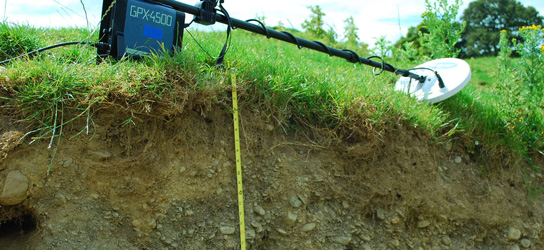“How deep does your metal detecor go?” How many times have you been asked this very question? Explaining how deep our metal detectors will go on small coins and rings is more difficult than it appears at first glance. There are several factors that can combine against you and cause a dramatic depth loss on in-ground targets. Air tests can be educational some of the time and may falsely show one detector to be better than another at finding a coin at twelve inches in-air. But, we don’t detect in air do we? We detect through the ground. Here are a few important factors that individually or combined can determine the depth achieved on buried coins and rings.

Mineralisation and salt
The presence of iron particles in the soil or wet salt beach sand has a drastic effect on the depth possibilities of most metal detectors. Although, mineralisation is the main problem with inland sites and wet salt is the headache for beach sites, you should be aware of the fact that salt exists in many inland areas as well.
While the range of Minelab technologies such as BBS, FBS and MPS work great in wet salt conditions and for the most part ignore this conductive effect, the MPS technology of the GPX gold detectors almost completely ignore this salt effect and has minimal effect on the depth and sensitivity.
Conductivity
One of the most important factors in whether or not a detector will respond to a target is that object’s Conductivity. Roughly speaking, this is the ‘ease’ with which an electro-magnetic signal can penetrate and flow through a metallic substance. Usually, the higher the ‘conductivity’ the easier it is for a detector to register a detection. Not surprisingly, different metals can have different conductivities. One interesting aspect of metals is that certain combinations (alloys) produce much lower combined conductivities than either of the constituents had. The example of 18 carat white gold is a case in point. Both silver and gold are highly conductive individually in their pure forms but when mixed to make white gold the resulting conductivity is very much lower.
Mass
The mass of an object is also very important. Irrespective of the metal the object is made from. If you significantly increase its mass you will usually improve its “detection factor”. Increasing the mass will not only increase the depth possibilities but also the amount of discrimination that can safely be used.
Try this experiment for yourself. Take two identical thin cupro-nickel coins and set the rejection to null or ignore one of them. Now put the coins together so they are “back to back” but not overlapping as this will double the surface area. The rejection signal should now be a ‘positive’ response.
In part 2 of this blog post I’ll explain some less well know aspects that can affect how deep a target can be detected.
Des Dunne




















Comments